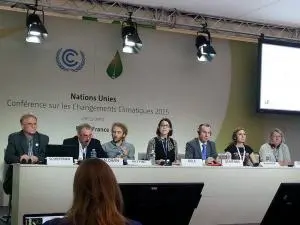COST Action IS1101 – Climate Change and Migration: Knowledge, Law and Policy, and Theory recently came to completion after four years of close collaboration between European and international partners from across the social sciences, humanities, legal and policy studies.
Senior Lecturer in the Department of Geography at Durham University (UK) and Co-Director of the Institute of Hazard, Risk and Resilience (IHRR), Professor Andrew Baldwin chaired this COST network focusing on improving our understanding of climate change-induced migration.
Human migration and the environment are two of the most pressing issues of our times. What is at stake when these two phenomena are articulated as a singular relation?
The discourse on climate change and migration is an extremely challenging one. What I find most striking about the relationship between climate change and migration is that it always seems to be framed as something that may occur in the future. Moreover, any attempt to identify a climate change migrant or a climate refugee in the present is impossible. We’ve realised that in practice, we cannot do it. The reason for this is that migration is not caused by any single variable. There are all sorts of different reasons why people migrate, such as war, economic conditions or household strategies to generate more income by temporarily sending a householder overseas.
Therefore, it is the peculiar dimension of this whole discourse on climate change and migration that I find so intriguing. The issue of climate migration is fascinating precisely because it is entirely reasonable to assume that, under conditions of climate change, migration will occur. And yet, empirically, this is almost impossible to prove.
Could climate change become the biggest driver of displacement?
No, I don’t think so. We are now in the midst of probably the largest migration that Europe has ever witnessed since the 2 nd World War. The climate migration community agrees on the fact that this phenomenon has nothing to do with climate change patterns. This is an obvious political crisis and people are fleeing their countries primarily for political and economic reasons. As for climate change-induced migration, it is extremely difficult to make predictions. We have no way of knowing what the numbers of people will be, where they will be coming from, what their patterns of mobility will be.
Migration is fundamental to human life and economy, and yet it elicits increasing antipathy around the world. Negative attitudes towards migration are intensifying. Is the migrant a threat to national security?
No, I don’t believe so. I am a migrant and I’m not a threat to the UK or European national security. I fall firmly in the camp that believes that migrants contribute economically to the host country. There are plenty of strong cases to be made in support of migration as a driver of economic growth. I am not an economist, but my understanding is that one of the best ways of increasing economic growth is by increasing levels of migration. That is particularly important in the European context where the birth rate of native-born Europeans is less than two children per household, which is not enough to sustain the kind of economic growth that Europe requires over the next twenty years. I think it would be wrong-headed to assume that migrants are a threat to security. I believe it is precisely the opposite.
In this sense, a very successful campaign that seeks to challenge the unfavourable prevailing media and public discourses, which have an important impact on public perceptions of migration, is the IOM campaign – i am a migrant. This project is extremely powerful, precisely because it tells the personal stories of migrants all over the world. Some are heart-wrenching, and some are not, but all of them are humanising, which is so important in today’s political climate.
What role can and should the EU play to sufficiently respond to the challenges of climate change and migration in these kinds of settings?
It is a good question and certainly one that we’ve been giving a lot of consideration to. I think that one of the main contributions that the European Union can make and has been making over the last decade is funding research in this area, thus developing a more sophisticated analysis of the interrelationships between particular types of environmental change and the mobility that may result from it. Another major contribution could be emphasising the idea that migration, in the context of climate change, is a legitimate adaptation strategy. Historically and nowadays, it has often been said that migration represents a threat to international or national security. The smart counter-argument is that migration is a legitimate mechanism for adapting to environmental change. It is something that human beings have always done and will continue to do. Therefore, I am convinced that the European Union can play a very strong role in advancing the principle of migration as a sustainable adaptation strategy. But additionally, the EU needs to remain mindful that adaptive migration is not available to all people equally. The risk of advocating adaptive migration is that some forms of migration will invariably be characterised as maladaptive, which could lead to detrimental outcomes for those people. In fact, I argue that drawing a distinction between ‘adaptive’ and ‘maladaptive’ forms of migration is a deeply political undertaking. Civil society, not least the social sciences and humanities, therefore, has an important role to play in scrutinising the discourse on adaptive migration.
Is human mobility already incorporated within climate change strategies? Is there any policy in place to support people who have to re-locate as a consequence of climate change?
We are still very much in the early stages of policy development in this area. The Cancun Adaptation Framework made reference to migration in the famous paragraph 14(f). Basically, this reference was a call for more research on the topic of climate change and migration. Interestingly, however, the climate change agreement recently concluded in Paris has a much reduced mandate to address migration issues. Instead,it contains a mandate to address displacement which can include but is not reducible to migration. This is a major policy development. Additionally, many developing countries are beginning to include the mention of migration in their National Adaptation Programmes for Action. And then there’s also the Nansen Initiative which was a global consultation that sought to develop a process for agreeing on a protection agenda for those displaced across international boundaries, as a result of environmental disasters, including climate change. All of these are important areas of policy development, however, it’s safe to say that these developments are still in their early stages. I would argue that what the ‘world’ really needs is a fulsome debate about what kind of migration is needed for the twenty-first century. Once this question is settled, only then should we start thinking about the kinds of policy arrangements that might get us there. The Sustainable Development Goals and the Nansen Principles might be a good starting point for this dialogue.
Can you tell me more about the COST Action? What progress has been made with regard to social sciences and humanities research for understanding climate change-induced migration?
The COST Action was important because through it we created a space for a more critical debate on climate change and migration. Whereas typically, this topic is understood as a problem that demands some type of direct policy intervention or policy solution, the COST Action allowed us to ask questions about how climate change and migration relates to wider debates in social sciences such as neoliberal governance, migration and labour mobility. We’ve also looked at the ways in which the climate migrant is constructed in the media. Here the most important thing to mention is that the figure of the climate change migrant is regularly constructed as something to fear, a figure that threatens. Sometimes, the figure of the climate migrant is constructed as a hapless victim. In my mind, this is significant because ‘threat’ and ‘victimhood’ are two of the most dominant racial tropes in use nowadays, which suggests that the discourse on climate change and migration might be inadvertently implicated in wider questions about race. This is something we need to take very seriously, especially given that animosity towards migrants is so prevalent nowadays.
Another important outcome of the Action is that for the first time ever, we have built a vast network of scholars working on this topic. We now have in our database more than 300 researchers – most of whom are European, but many of them are also from the USA, Canada, Australia, Bangladesh, India and Africa. This is a major accomplishment and, dare I say, it’s just the beginning as more and more people are becoming interested in migration and climate change. It’s a very hot topic.
Social science research is not typically designed to make new discoveries. What social sciences are really good at doing is asking difficult questions and developing innovative methods in order to better understand an issue. Sometimes this will result in agreement, other times not. But that’s the very heterodox nature of knowledge. In this sense, one thing our Action achieved was to pluralise how we understand the discourse on migration as adaptation.
What is most interesting is the way in which the phenomenon of climate change and migration is now increasingly framed as a problem of human security and economy more so, it seems, than one of military security. For example, when migration is said to be a legitimate form of climate change adaptation, this is often justified in terms of the benefits of remittance economies, access to labour markets, circular migration, and risk management – mobilising the lexicon and policy strategies that characterise mainstream debates on migration in the last decade. This suggests that the discourse on climate change and migration is adopting the language of neoliberalism, but it also suggests that this discursive shift may come with various material effects, for example, in terms of the institutions legitimated to govern climate migration, of the policies to which prospective climate migrants are subjected, of the forms of mobility fostered.
Our COST Action took the debate one step further, asking – for whom principally is migration seen as an adaptive response to climate change? Is this a principle benefitting vulnerable people or more likely the receiving countries that can therefore have particular labour needs (e.g. short-term labour needs)?Is it supposed to create a flexible mechanism for managing labour mobility in the context of climate change? We can’t necessarily answer all these questions, but we’ve begun to raise them and I think this is extremely important.
Who would be the beneficiary of this Action?
My hope is that people living in vulnerable places around the world are the principal beneficiaries of this Action, in particular those living in developing countries. Much of the conceptual and methodological work that has gone on in the Action was undertaken with vulnerable populations in mind.
Did the Action manage to include policy makers, non academic participants?
Absolutely, Dr Koko Warner from United Nations University was one of the Co-Chairs of Working Group 1. She did a remarkable job of bringing a lot of policy makers into the fold. My colleague, Dr François Gemenne from the University of Liege,played a very similar role. In fact, we had a workshop at the end of 2014 that was explicitly focused on research and end users, so the International Organisation for Migration and the Red Cross were there. And thanks to COST I was able to host the world’s largest ever academic conference on climate change and migration. Many of the conference delegates were from the policy community.
We’ve realised that the work that we do has to be made available to practitioners. Therefore, we involved, for instance, a UK-based group called the UK Climate & Migration Coalition, which is an alliance of refugee, human rights, development and environmental organisations. Practitioners have particular research needs, so involving them in a number of our COST Action’s activities gave us the opportunity to listen to their concrete needs. We also collaborated with a UK-based artist collective called Virtual Migrants. They have been working on different societal issues, but principally have created artwork relating to refugees and migration.
What have been the most important outcomes of the Action?
I think it would be hard to identify any one outcome or benefit, but if I had to I would say that we cultivated a spirit of mutual trust and respect amongst a rather polyglot group of researchers with a shared interest in migration and climate change. I have long been arguing that climate change and migration is not only a problem to be solved through public policy, but is instead best understood as a political issue and therefore one around which there is intense disagreement. My claim is that if we cherish democracy, then we need to acknowledge and respect the disagreement that lies at the core of the debate about climate change and migration. In my mind, one of the most important outcomes of the COST Action is that we managed to create a culture of trust among a vast group of researchers who don’t necessarily agree on even the most basic things, such as research methods and interpretative frameworks. This to me is for the good.
A significant outcome of our COST Action occurred a few weeks ago at COP21 in Paris. Our Action staged a side-event on the importance of the social sciences and humanities for understanding climate change and migration . At the side-event, my COST Action colleagues presented their research findings, which were very diverse, ranging from insights about conflict, discourse and the political nature of the phenomenon to questions of terminology, policy development and gender. In my opinion, the most important aspect about this side-event was that we had such a high-level of trust and respect amongst all those present. It also underscored the imperative that we must continue to pluralise how we understand climate change and migration. We cannot leave this topic to one form of research, one method, or one interpretative framework. This is a multifaceted area of research that requires a plethora of questions, methods and analyses. My hope is that we can continue to build on this foundation of trust in the years ahead. This is a sensitive area of research and trust is extremely important at this critical juncture.


